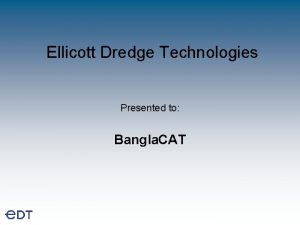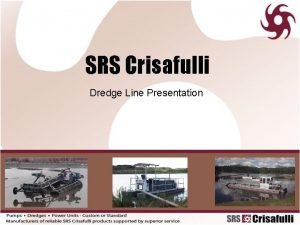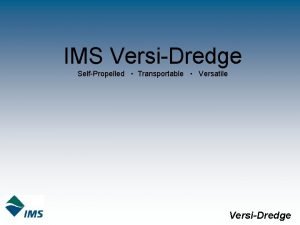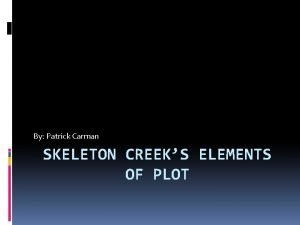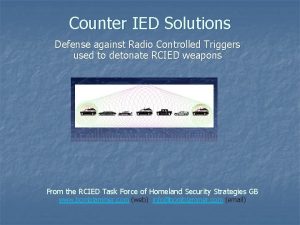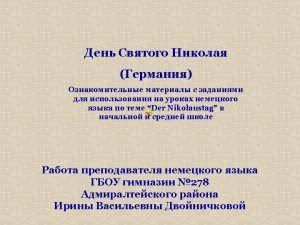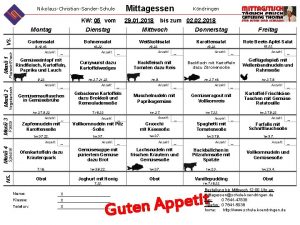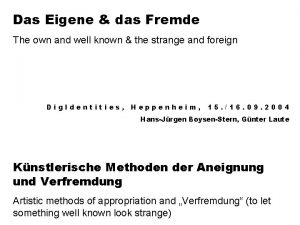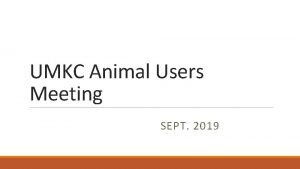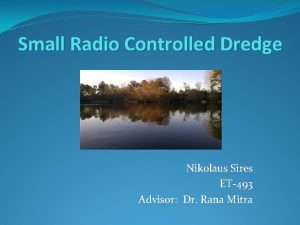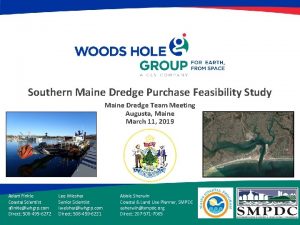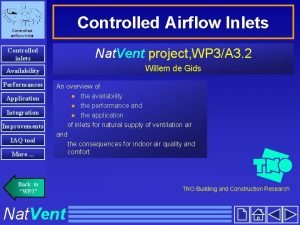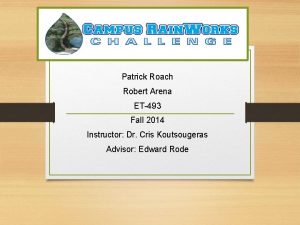Small Radio Controlled Dredge Nikolaus Sires ET493 Spring



















- Slides: 19

Small Radio Controlled Dredge Nikolaus Sires ET-493 Spring 2015 Instructor: Dr. Cris Koutsougeras Advisor: Dr. Rana Mitra Concentration: Engineering Technology/Mechanical

Problem 1 �The site of this senior project is a pond of approximately three acres. �I desire to remove one foot of loose sediment from the bottom. �This amount of sediment would be approximately 5, 000 cubic yards. (A percentage of this will be water)

Problem 2 �The site is surrounded by trees, and I desire to minimize the environmental impact to the location. �Typical remote controlled dredging systems are large and cumbersome.

Solution �I propose the construction of a small, partially radio controlled dredging system. �Propulsion could be achieved through the use of a trolling motor/motors. �Dredging could be done through the use of a small trash pump mounted to a floating platform, or an electric pump powered by a small generator.



Steering & Throttle servos

Displacement: �When calculating how the dredge would sit in the water, several calculations were made. �A total weight of 709 lbs. was calculated based on manufacturer specifications for each component �Total Capacity of the barrels was used to find the percentage of the barrels submerged based on total weight of the dredge and the density of water at 70 degrees Fahrenheit �Once the percentage was calculated, the surface area of one barrel’s end was used to determine the height of the circle segment above the water. This value was 6. 44”


Trolling Motor: �When selecting a suitable trolling motor for any watercraft, consideration must be given to hull type and total weight of the craft �The intended design of this craft is a pontoon configuration �The estimated total weight of this craft is 709 lbs. �Trolling. Motors. Net recommends at least 2 lbs. of thrust for every 100 lbs. of weight �I have selected a Minn Kota Endura C 2 with a thrust rating of 50 lbs.

Trolling Motor Selection:

Other considerations �How to catch the sediment removed �How much of one hour can be devoted to actual dredging, and not relocation of the dredge system

Preliminary numbers �Typical small trash pump capable of moving up to 16, 000 gallons per hours �At 50% efficiency and 50% of the material being sediment and not water, this equates to 20 cubic yards per hour with dredge working the entire hour. �It took about 8 hours for me to move 1 cubic yard of material (with the pond drained)

Deliverables �Examine the pros/cons of a pump centered system vs. a generator based system �Take sediment samples from various locations in the pond and determine average pond depth �Make selection of system type based upon soil sample findings �Draw design plans to allow ease of system access based on findings of average pond depth �Complete cost analysis of dredging system costs �Study methods to efficiently collect dredged pond sediment �Begin purchasing materials and assembly of dredging system

Timeline �System type study �Take sediment samples �Choose system type �Design plans �Cost analysis �Collection methods �Component Research/Purchases �Begin assembly/Testing 3/05/2015 - 3/19/2015 3/16/2015 - 3/23/2015 3/24/2015 - 3/26/2015 3/21/2015 - 4/04/2015 - 4/11/2015 5/11/2015 - 7/04/2015 5/18/2015 - 8/25/2015

Sediment Sample Collection

Two samples were taken from four locations. (North, South, East, and West sections of pond)

The samples were allowed to settle for a few weeks. It was found that all areas, other than the West side, were primarily sediment (approximately 85%).

Parts List/Cost Analysis: 4 – 30 gallon drums / $256. 00 2 – High Torque Servos / $200. 00 2 – 12 v Batteries / $150. 00 1 – 2” Trash Pump / $300. 00 2 – Electric Winches / $150. 00 66’ – 2 ½” x 3/16” Steel Angle / $300. 00 1 – Trolling Motor (50 lbs. thrust) / $150. 00 1 – Radio Control System / $300. 00 Miscellaneous Parts / $200. 00 TOTAL COST = $1, 956. 00 + applicable sales taxes
 Dr eric simard
Dr eric simard Ellicott dredge technologies
Ellicott dredge technologies Dredge line
Dredge line Versi dredge
Versi dredge Skeleton creek dredge
Skeleton creek dredge Counter ied jammer
Counter ied jammer Wer war nick knatterton
Wer war nick knatterton Klopf klopf klopf wer klopft an unser haus
Klopf klopf klopf wer klopft an unser haus Nikolaus kopernikus lebenslauf
Nikolaus kopernikus lebenslauf Smiley face tricks examples
Smiley face tricks examples Scratch haus vom nikolaus
Scratch haus vom nikolaus In einem klitzekleinen haus schaut der nikolaus heraus
In einem klitzekleinen haus schaut der nikolaus heraus Vegetarisches men?
Vegetarisches men? Nikolaus huss
Nikolaus huss Nikolaus lang für die geschwister götte
Nikolaus lang für die geschwister götte How seasons work
How seasons work Four seasons korean movie
Four seasons korean movie Trunking vs conventional radio system
Trunking vs conventional radio system I'm a real spring chicken and im having a ball
I'm a real spring chicken and im having a ball Controlled substance log example
Controlled substance log example

